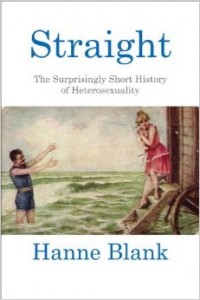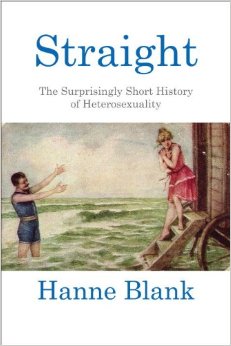 Straight: The Surprisingly Short
Straight: The Surprisingly Short
History of Heterosexuality
by Hanne Blank
Beacon Press. 264 pages, $26.95
THIS NEW LOOK at sexual orientation by the erudite and versatile Hanne Blank is not the first of its kind. Blank acknowledges her debt to Jonathan Katz’ The Invention of Heterosexuality as a forerunner of this study. However, the evidence that “heterosexuality” was invented, not discovered—and quite recently at that—bears repeating. As Blank points out, if “the attribute we now call ‘heterosexuality’ were a prerequisite for people to engage in sex acts or to procreate, chances are excellent that we would not have waited until the late nineteenth century to figure out that it was there.”
It is Blank’s contention that the parallel terms “heterosexual” and “homosexual” were coined, not in a scientific or medical context, as is generally assumed today, but in a quasi-legal context. To be “homosexual” was to have a particular sexual identity. When used by opponents of a drastic 1851 German law that criminalized sexual “deviance,” the term implied that legally persecuting “homosexuals” was irrational, since they were not sinners (as under earlier canon law) but were simply expressing unusual desires that were natural for them. Although Blank is not the first historian to discuss the development of the concept of sexual orientation, her explanation of the social context is intriguing. As she shows, medieval Christian definitions of sexual sin (non-reproductive or non-marital sex) had a great influence on later conceptions of “abnormal” erotic attraction, which could only be understood in contrast with the “normal” kind.
Richard von Krafft-Ebing’s 1886 book Psychopathia Sexualis aimed to be a scientific study of abnormal expressions of sexual behavior, ones that generally appeared in cities, where they were harder to control than in insular villages. He used the terms “normal-sexual” and “heterosexual” (attracted to those who are different from oneself) almost interchangeably, in contrast to the various types of sexual deviance he sought to define. However, the concept of a “heterosexual” as a person who wants to mate exclusively with a member of the opposite sex didn’t solidify until the 1920’s.
In a series of chronological chapters, Blank explores the rise of psychology and its influence on changing models of “normal” personal development, and the emergence of heterosexual marriage as the sole expression of sexual maturity. While traditional marriage—in medieval times, for example—was an economic arrangement controlled by the husband and sanctioned by religious vows, the 19th century discovered “romantic” marriage with its symbiotic gender roles and notions of personal compatibility as prerequisites for a healthy marriage—one that could properly nurture the next generation.
Blank’s study is bracketed by a personal plea for a recognition of more sexual complexity than Krafft-Ebing could have imagined: “My partner was diagnosed male at birth because he was born with, and indeed still has, a fully functioning penis.” She goes on to explain: “Indeed, of the two sex chromosomes—XY—which would be found in the genes of a typical male, and XX, which is the hallmark of the genetically typical female—my partner’s DNA has all three: XXY, a pattern that is simultaneously male, female and neither.” Given her partner’s ambiguous gender identity, it follows that Blank’s own sexual orientation is ambiguous. While they seem to enjoy an enviably close and long-lasting relationship, the question arises whether they are a “straight” couple in some sense and, if not, how their sexuality should be defined.
Hanne Blank is an engaging writer, and her personal stake in the subject makes her analysis both interesting and immediate. This book is a useful addition to a general opening up of binary conceptions of sex and gender that seems to be happening in our society.
________________________________________________________
Jean Roberta is a writer based in Regina, Saskatchewan.






